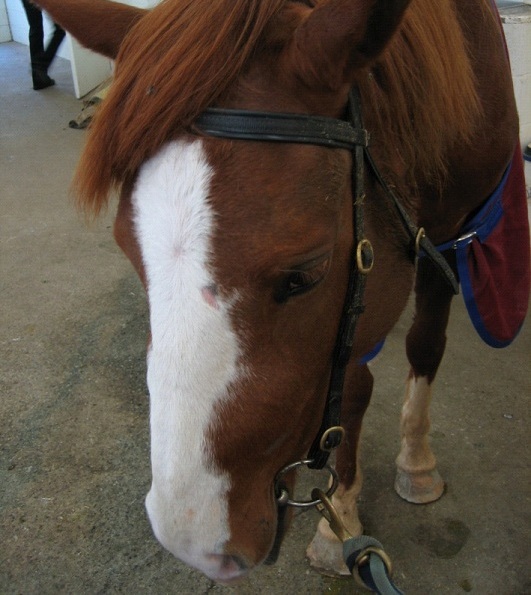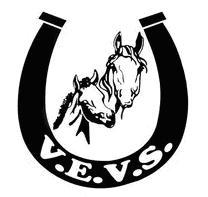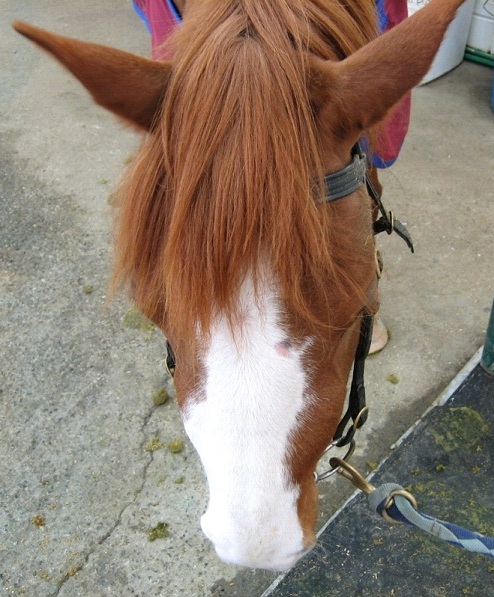Bighead is a common disease in south east queensland and it is due to inadequate calcium absorption. The usual way that this occurs is when horses are grazing grasses that contain high levels of oxalates.
The oxalate in the pasture attaches to calcium in the horse's gut, forming calcium oxalate which prevents the horse from absorbing calcium. Oxalates are contained in grasses including buffel grass, setaria, kikuyu and panic grass. Therefore although the horse may be eating adequate calcium in the diet, it is in a form that can not be absorbed and therefore deficiency results. Adequate blood calcium levels are vital for survival as calcium is an essential factor in cellular function of all body systems, blood clotting and nerve and cardiac and skeletal muscle function. When body calcium levels fall parathyroid hormone is released from the parathyroid gland. This hormone causes the kidneys to increase excretion of phosphorous in the urine and to reabsorb calcium. It also causes increased absorption of calcium from the gut. However, if the horse is not absorbing enough calcium due to it being bound by oxalates, these compensatory mechanisms are ineffective. As the severity of the calcium deficiency increases parathyroid hormone causes calcium to be reabsorbed from the bones. This results in greatly weakened bones, enlargement and replacement by fibrous tissue. The name “bighead” developed because the facial bones are most severely affected by this disease.
Bighead can also be caused by diets excessive in bran and grains. These diets are high in phosphorous and low in calcium and contain phytates which bind calcium in the gut in a similar way to oxalates. The calcium is then unable to be absorbed by the horse and deficiency results. An old name for this condition was “Bran Disease”.
Horses most prone to bighead are those that are pregnant, lactating or exercising and therefore sweating heavily. These horses have increased calcium requirements and therefore show deficiency more readily. Blood and urine calcium levels can be measured, however, these are inaccurate in representing body calcium levels.
Clinical Signs
Bighead affected horses can present with a number of different clinical signs. They may lose weight, have a coarse, stark coat despite being on a seemingly adequate diet. Swelling of the facial bones is a common sign as these bones are the most severely affected by calcium resorption. These changes are usually symmetrical on each side of the head. Severe cases may experience difficulty breathing due to narrowing and obstruction of the nasal passages. They may have loose teeth or pain during eating. They can also have an irregular or shifting lameness or a stiff gait. This is due to weakening of the bones as calcium is mobilized and replaced by fibrous tissue. X-rays can show an abnormal trabecular pattern, where the structure of the bone is porous and is less dense. These changes are usually only seen when 30% of the mineral density of the bone is lost. Severe cases may also experience tendon ruptures.
 Treatment and Prevention
Treatment and Prevention
Horses grazing oxalate containing pastures and those affected with clinical signs of bighead should be provided with daily calcium supplementation. Agricultural lime (calcium carbonate) provides more calcium than dolomite (approximately 40% versus 20% calcium). Dicalcium phosphate is an ideal supplement as it also addresses the phosphorous deficiency that these horses also commonly develop and helps keep calcium and phosphorous levels in balance. Daily supplementation is far more effective than weekly supplementation. It is impossible to calculate the exact requirements as the losses are affected by the levels of oxalate in the pasture and the degree of calcium deficiency in the horse. It is necessary to supplement the horse with levels far exceeding the daily requirements as not all of the calcium is absorbed. It is also important to provide mineral supplements containing magnesium, which increases calcium absorption and ensure that other essential mineral requirements are met. As a guide, up to 100g calcium carbonate (lime) and 200g dicalcium phosphate can be fed to a 500kg horse each day. This is tolerated better when mixed with molasses.
The effectiveness of supplementation can be determined from the improvement in clinical signs. Supplementation should be continued for 6 months or indefinitely if the horse is to be kept on the offending pasture. Lucerne hay is also high in calcium and should be given in addition to the calcium supplements. It is not sufficient on its own to provide adequate calcium to compensate for the losses. Liming the paddocks or drinking water does not provide sufficient calcium supplementation. Vitamin D is also ineffective in reversing this condition, although it is needed for calcium absorption, the problem with bighead is not absorption but inadequate calcium present as it is bound by oxalates.











